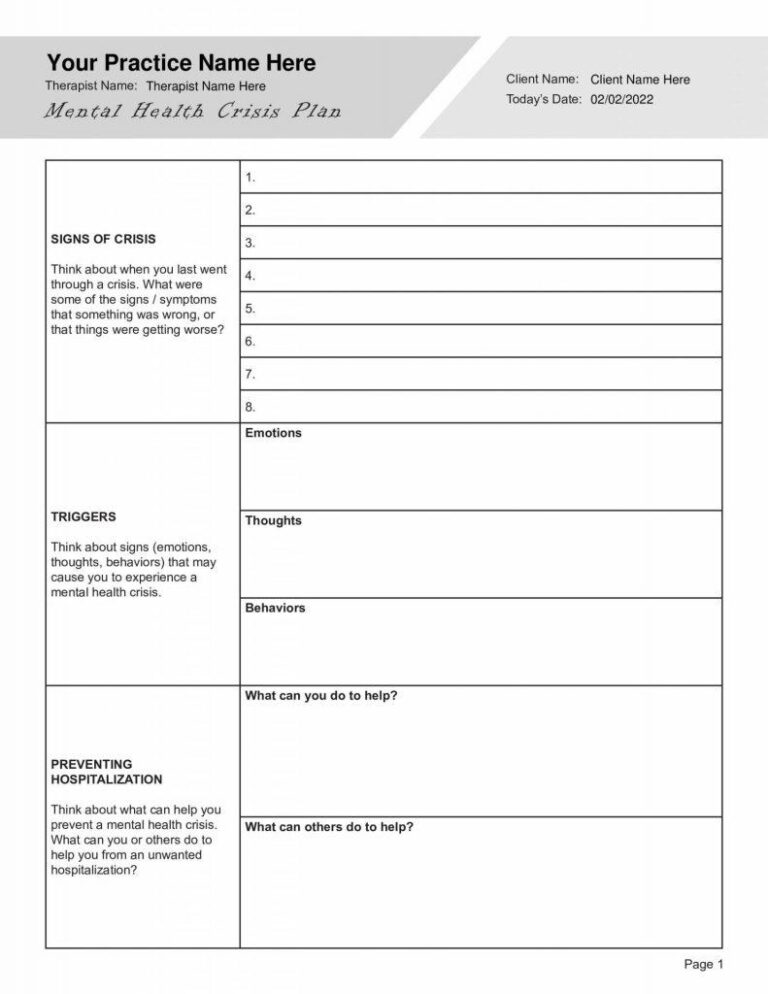When it comes to mental health, being prepared for a crisis can make all the difference. Just like having a plan for physical emergencies, creating an effective mental health emergency plan ensures that you or a loved one can navigate challenging moments with greater clarity and support. In this article, we’ll explore practical steps and essential elements to help you develop a complete plan tailored to your unique needs. whether you’re looking to safeguard your own well-being or assist someone close to you, understanding how to prepare for a mental health emergency is a vital skill that promotes resilience, safety, and peace of mind.
Table of Contents
- Understanding the Importance of a Mental Health Emergency Plan
- Identifying Key Triggers and Warning Signs to Monitor
- Developing Clear Action Steps for Immediate Response
- Building a Support Network and Communicating Your Plan Effectively
- Key Takeaways
Understanding the Importance of a Mental Health Emergency Plan
Mental health crises can arise unexpectedly, frequently enough leaving individuals and their loved ones feeling overwhelmed and unsure of what to do next. Having a thoughtfully designed emergency plan acts as a critical safety net, ensuring timely access to support and resources when emotions run high.It not only provides clarity during moments of confusion but also helps reduce fear and stigma by normalizing proactive mental health care.an effective plan empowers people to take control, fostering resilience and promoting recovery even in the most challenging situations.
Building such a plan involves more than just listing emergency contacts; it requires a comprehensive approach that includes:
- Identifying early warning signs that signal a potential crisis
- Compiling a list of trusted support persons, including mental health professionals and close friends or family
- Outlining coping strategies and calming techniques that have proven effective in the past
- Documenting preferred treatments and medications in case medical help is needed
- Creating a step-by-step action plan to follow when symptoms escalate
This strategic readiness gives individuals a concrete resource to turn to, alleviating uncertainty and enhancing their ability to manage crises with confidence.
Identifying Key Triggers and Warning signs to Monitor
Recognizing the specific triggers and warning signs that precede a mental health crisis is the cornerstone of any emergency plan. These triggers can vary widely from person to person but frequently enough include factors such as increased stress, significant changes in mood or behavior, sleep disturbances, or withdrawal from social interactions. It’s vital to document these signs precisely, as they serve as early alerts that intervention might potentially be needed. Common triggers to watch for include:
- Exposure to stressful environments or events
- Substance use or abuse
- Feelings of hopelessness or worthlessness
- Sudden loss or change in relationships
- Neglecting personal hygiene or daily responsibilities
Keeping a detailed record of these indicators not only aids in self-awareness but also equips loved ones and healthcare providers with critical data. This awareness empowers them to take timely, appropriate action that can prevent escalation. Collaborating with a mental health professional to tailor the identification of these warning signs ensures the plan is both personalized and effective, creating a safety net precisely calibrated to the individual’s needs.
Developing Clear Action Steps for Immediate Response
When facing a mental health crisis, having clearly defined actions to follow can be the difference between chaos and calm. Start by identifying key signs and triggers that indicate an immediate need for intervention. Next, designate specific roles for those involved in the response—whether it’s family members, friends, or health professionals. Outline precise steps that include contacting emergency services if necessary, administering prescribed medications, and providing a safe surroundings free from potential harm. This framework ensures everyone knows their responsibilities, fostering a swift and organized reaction during critical moments.
Additionally, compiling a fast-reference list of emergency contacts is essential. This shoudl include therapists, psychiatrists, local crisis hotlines, and trusted friends or family members. Consider incorporating bullet points for easy visibility:
- Primary mental health provider contact info
- Emergency medical services
- Trusted personal contacts available 24/7
- Local crisis center numbers
By preparing these clear and actionable steps ahead of time, you minimize hesitation and confusion, enabling a compassionate, timely response that prioritizes safety and emotional support.
Building a Support Network and Communicating Your Plan Effectively
Establishing a reliable support network is a cornerstone of any mental health emergency plan. This network should include trusted friends, family members, and mental health professionals who understand your unique needs and triggers. Communicating openly with these individuals ensures they know how to respond in a crisis and can provide timely assistance. be clear about your emergency plan details, such as warning signs, coping strategies, and preferred interventions, so your support system can act confidently and effectively.
Consider these strategies to enhance dialogue:
- Schedule regular check-ins to update your plan and discuss any changes in your mental state
- Provide written documentation of your emergency steps to avoid confusion during high-stress moments
- Empower your support network with knowlege about your condition and crisis management techniques
- Utilize digital tools like shared notes or emergency contact apps for instant access to your plan
Key Takeaways
Creating an effective mental health emergency plan is a vital step toward ensuring safety and support during challenging times. By taking the time to identify triggers, outline coping strategies, and establish a trusted support network, you empower yourself or your loved ones to navigate crises with greater confidence and clarity. Remember, an emergency plan is not a one-time task but a living document that should be reviewed and updated regularly. Prioritizing mental health preparedness today can make all the difference tomorrow—as when it comes to mental well-being, being ready means being resilient.

